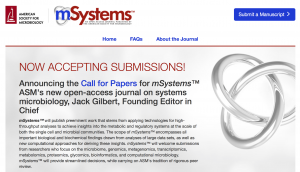Yet Another Microbiome Journal?
Jack A Gilbert
Earlier this year I was invited by the American Society for Microbiology (ASM) to be the Founding Editor in Chief of a new journal that they insisted would add to the cadre of existing publications supported by the ASM. As a constant editor I was interested, but also rather incredulous that the field needed another journal. Importantly, having only just released mBio — which has become a very successful vehicle for publishing high-impact microbiology research — why did ASM’s journals board feel like they needed another journal? Then I found out they were actually launching 2 new journals! To be honest, I nearly walked away right there and then.
I had been a long supporter of PLoS One, as an academic editor and then section editor, and then in 2013 I took on senior editor positions at ISME Journal, Environmental Microbiology and Environmental Microbiology Reports. Some might say I am just a sucker for punishment: likely true. From these 4 journals I was handling 3-4 new articles a day, which I have to digest, decide whether to send out for review, find reviewers for, and then handle through to rejection or acceptance. That is a lot of extra work to do, on top of running a lab, etc.
As an aside, if you want to make an editors life easier write a great cover letter. This is one that states exactly why your findings represent a significance advance on previous knowledge. You want me to send your article out for review, then telling me why your article is important is a really important step. Either way — when ASM approached me I was starting to feel burn out from handling so many manuscripts, and to be honest was not really happy at the thought of more. But the approach and rationale outlined by the team at ASM, and the freedom they granted me to craft the journal I wanted to run and publish in as an author, was very compelling.
To that end, we have launched mSystems, a new open access (CC BY) journal that supports the publication of articles covering all aspects of microbial systems biology. Including intra-cellular systems to ecosystems. This fills a glaring gap in the cadre of ASM journals by providing a forum for rapid dissemination of studies that use omic approaches to characterize and understand mechanisms that drive cellular and community level processes.
Obviously, there are other journals out there that could support the publication of such articles, yet many are facing serious problems with editorial and reviewer delays-to-decision, and are often articles other than those with a primary systems biology focus. So here is the new home for microbial systems biology research, supported by the venerable ASM, and by a cadre of some of the most collaborative and well-respected scientists in our field.
To make the journal stand out we have specifically created a hierarchical filtering system. I will be the gate keeper, making sure that the quality of articles coming into the journal for review is high, this decision will be ratified by one of the senior editors, who will then select an editor, who will provide a 3rd level of peer-review scrutiny, and will be responsible for securing rapid reviews from the community, and then who will make a rapid editorial decision to revise, accept or reject. The Editors have the power, and we have selected a range of experts from a broad swathe of the community who represent people I trust and admire to make quick, difficult decisions.
To ensure that each article is given an appropriate forum we will leverage social media (primarily through @msystemsj) and also an array of advertising techniques. For example, we will encourage the authors of each corresponding article to provide a 1 minute video explaining the impact of their findings, which will be posted along with the article. This provides an opportunity for improved media interaction, and for researchers to devise clever ways to highlight the importance of their study.
We represent the community, and we have great expectations for the quality of work we would like to see in the journal. We will not be after flashy articles that grab a lot of attention, we want to ensure that the body of work published in this forum sets a standard for scientific excellence, and provides a resource for the community that they can trust. Each of our editors will only have to handle 1-2 articles a month, and so each editor will dedicate time to ensuring the quality and rapidity of the peer-review process.
We look forward to exploring to creating this new venue with the scientific community, whom we both represent and support in equal measure. The diversity of the community is well represented, with editors in an equal gender ratio and from a broad swathe of the globe. So send us your excellence research, and like colleagues we will assess, provide feedback, and help to disseminate the best you have to offer.

And we’re thrilled you accepted the invitation to lead ths new OA journal, Jack!
We were invited to Publish to mSystrmS by the Chief Editor of mBio. I never heard about the Journal before. After reading your post I got enthusiastic about that idea.
We just were invited to Publish in mSystems. After reading your post I got enthusiastic about it